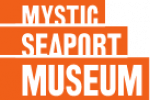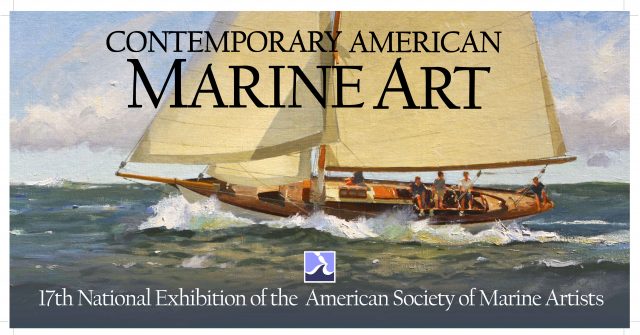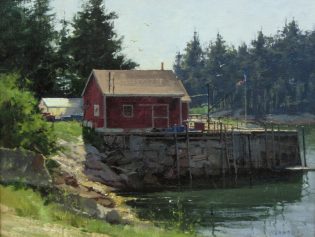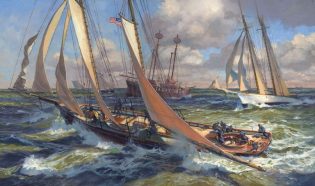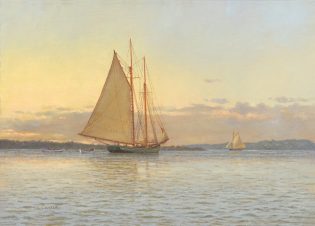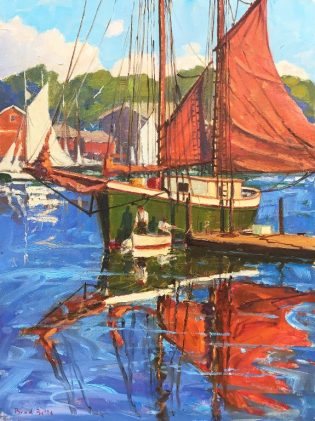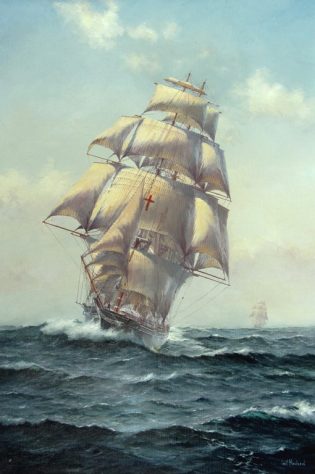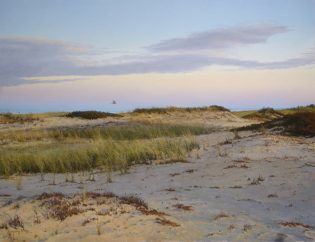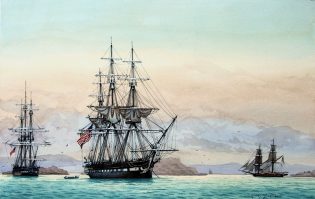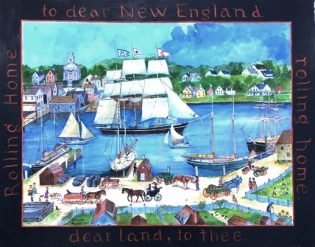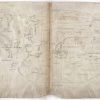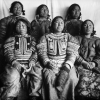On Saturday, October 14, Mystic Seaport opened Contemporary American Marine Art: The 17th National Exhibition of the American Society of Marine Artists. This exhibition highlights the works of artists recognized as the best working in the marine art field today. The exhibition was curated by a juried competition held by the American Society of Marine Artists (ASMA), and includes 120 works of painting, sculpture, and scrimshaw from the nation’s leading marine artists. Selected from more than 500 paintings and sculpture submitted for consideration, the works represent a wide variety of subject matter, medium, technique, and inspired vision. The exhibition runs through through January 21, 2018.
The exhibition is hosted every three years in museums across the United States, and debuted on September 8, 2016, at the Muscarelle Museum of Art, in conjunction with the First National Marine Art Conference in Williamsburg, VA. The exhibition then traveled to the Chesapeake Bay Maritime Museum in St. Michaels, MD, and the Academy Art Museum in Easton, MD, and continued to the Quinlan Visual Arts Center in Gainesville, GA, and the Minnesota Marine Art Museum, in Winona, MN.
This week, ASMA has its National Marine Art Conference in Mystic, the second such conference the organization has staged. The conference, from October 18-22, offers lectures and demonstrations. We asked Kim Shaklee, President and Fellow of ASMA, to answer five questions for us.
Q. Why does ASMA do this exhibition?
A. The purpose for holding our National Exhibition is twofold: The Society believes it has a responsibility to provide an opportunity to our members to submit works to be juried by the Fellows for a National Exhibition every three years. Such exhibitions are promoted through some of the top Museums around the country. It is a way for members to hone their artistic skills to become the very best in their field. Competition is fierce, and as such, members know they must submit exceptional work to garner a spot in the exhibition. This inspires members to become better artists.
On the flip side, it is critical to keep an awareness for maritime art in the public’s eye. The subject matter has been around for centuries, however our organization has evolved to be so much more than a small group of artists who paint boats and seascapes. With 500 artists, there is so much diversity in what we have to offer – something for nearly every age group to appreciate.
Q. How does the selection process work for the pieces in the show?
A. Regular members are eligible to submit anywhere from one to three works to the show, but they are not required to do so. Only one piece may be selected from an artist.
Those who have attained the membership level of Signature Members are required to submit at least one piece for consideration to each of the ASMA National Exhibitions. Fellows are required to display one work in each National exhibition, and are not subject to jurying. With 19 Fellows, 174 Signature members and nearly 300 Regular members, there are usually 450 to 700 entries for each and every national show.
The Fellows have a dual process for selecting the works for the show. Members submit online through a special provider, which tracks submissions until it is time for the jury to convene. All Fellows review the images online once the submission deadline has closed. The Fellows then meet in person to make their final selections from the submitted images. Fellows unable to attend in person are allowed to submit their jury scores online. Images are ranked individually on a point system from 1 to 7 (1 being lowest, 7 being highest), with each Fellow’s vote being tallied. Most Fellows attend the meeting for the selection process, as it is one of the most important obligations of Fellowship. Each Fellow is asked to give input regarding their area of expertise for both medium and subject matter. This is a crucial part of the selection process.
Q. As you look at the exhibition, is there something that stands out that is different or unique from past years?
A. As time passes we are seeing more diverse subjects being explored in various mediums. Traditional maritime art is still alive and well, but many artists have become interested in portraying water subjects, endangered species, and environmental issues pertaining to each of us. The possibilities are endless. Artists have become bolder in presenting unusual vantage points to their paintings, or obscure watercourses; many different nuances are sought to individualize themselves from what is typically thought of as “marine art.”
Q. How does the Exhibition support the mission of ASMA?
A. By drawing attention to all things maritime: whether historical subjects, peaceful waterways, the emotions one feels when looking out to sea, preservation of endangered marine mammals and birds, the educational aspect of students participating in our Young Marine Artists Search program, which has taken the top students to the pinnacle of opportunity by having their work exhibited at Mystic Seaport. There are many tributaries that are intertwined. All these keep the American Society of Marine Artists proud and strong. We are building our future each day by supporting the passion our artists have for marine art.
Q. Is there a quality or characteristic of maritime art that you would like exhibition viewers to appreciate?
A. Maritime art relates to each person in a different way. We are a planet that is sustained by water. Water is a necessity of life and an emotional component to who we are.
Marine art has broadened its focus to include anything related to water, including what lives in it and around it. The visceral effect of the Sea has been apparent as long as humanity has record events. How we choose to relate to marine art is shaped by our own life experiences.
The American Society of Marine Artists 17th National Exhibition has something that every person can relate to in some way. It is up to each viewer to discover the mysteries that live within our hearts as artists.
